Pleasant Brook History
Pleasant Brook is a development of thirty-four contemporary style houses constructed between 1967 and 1979 located off Pleasant Street and Peacock Farm Road in the southeastern part of Lexington, adjacent to the Route 2 corridor. The development is directly adjacent to and partially overlaps with the Peacock Farm neighborhood, and includes houses on Mason Street, which is accessed off Peacock Farm Road and Pleasant Street, and White Pine Lane, which is accessed off Mason Street and terminates in a cul-de-sac, and Pleasant Street. The Plesant Brook neighborhood, and all thirty-four properties within it, have been reconized by the Massachusetts Historical Commission for their historical and architectural significance. The following information details the basis of this significance.
 Two 'Peacock Farm' houses and two 'Deck House' houses in Pleasant Brook (Source: Lexington Historical Commission)
Two 'Peacock Farm' houses and two 'Deck House' houses in Pleasant Brook (Source: Lexington Historical Commission)
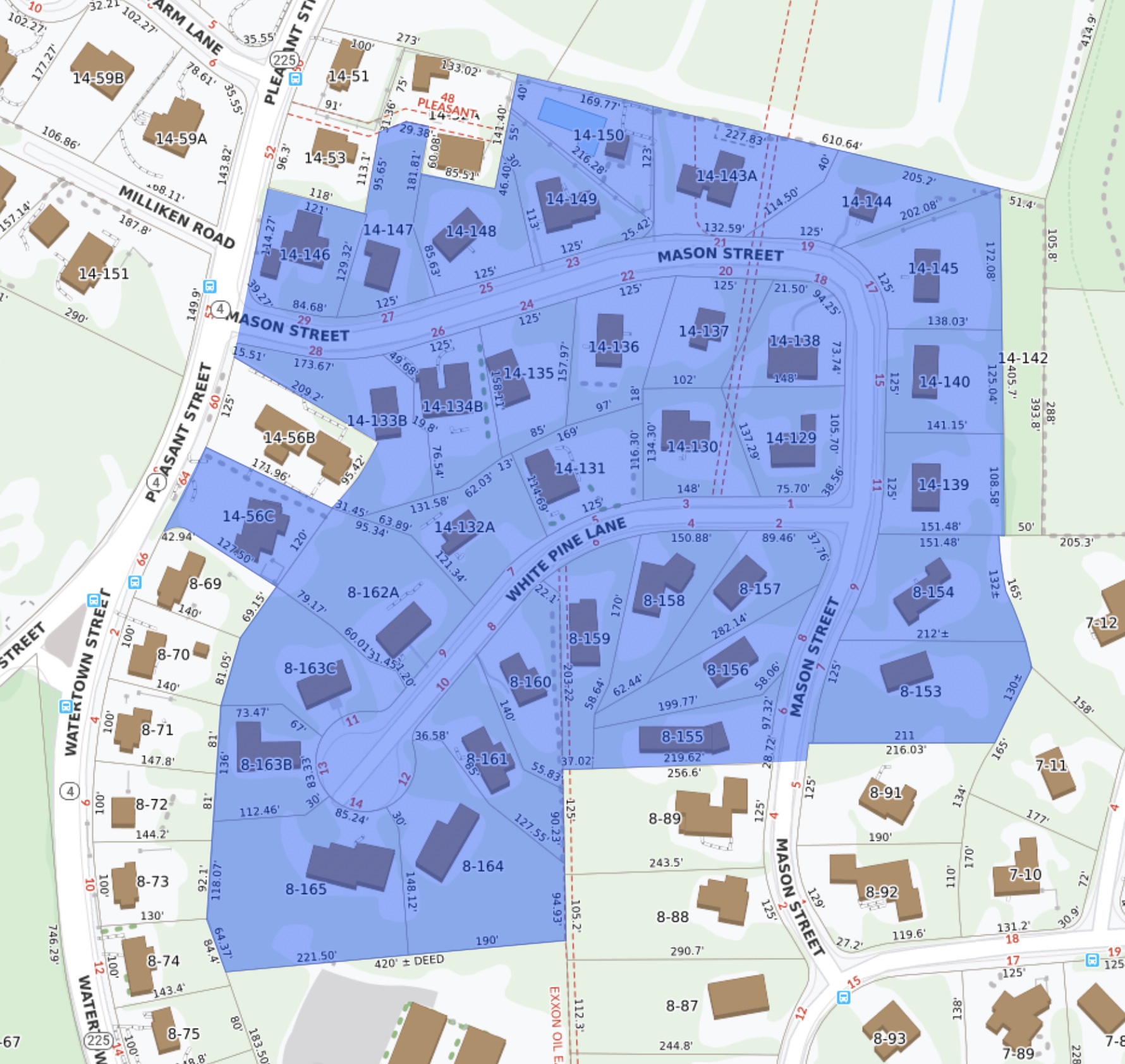 Map of the properties that comprise the Pleasant Brook area (Source: Lexington Historical Commission)
Map of the properties that comprise the Pleasant Brook area (Source: Lexington Historical Commission)
Architectural Design
As originally constructed, each of the Peacock Farm style houses in the development contained roughly 1,975 square feet of finished interior living space, across three distinct areas of the split-level design. The upper level of roughly 650 square feet consisted of two larger bedrooms, one smaller bedroom, and one or two baths. The roughly 675 square foot middle level contained the living room, dining room, kitchen, and distinctive brick fireplace. The roughly 650 square foot multi-configuration lower area contained a combination of bath, playroom, office, or additional bedrooms. With the Peacock Farm house having been in construction since 1955, the homes built in Pleasant Brook from 1967 to 1970 were able to incorporate improvements to the original design, including a roughly 625 square foot full-height poured basement under the middle level of the house, instead of the crawlspace used in the original design. Additionally, the middle level living area of most of the homes is 3 feet longer measuring 26' by 51' in plan, as opposed to a total length of 48' in the original design. The house design allowed for mirror-image versions of the plan, which enabled each house to be tailored to the siting and orientation on each lot, including the entrance to the house through a foyer on the lower level or on the middle level depending on the site characteristics. The two most common orientations of the house relative to the street are the broad side parallel with the street or the end of the house containing the upper and lower levels facing the street. The houses utilize a combination of wood and steel post-and-beam construction techniques, which allowed for large bands of windows and flexibility for interior room layouts with most internal walls non load-bearing. The structures have a shallow-pitched, asymmetric gable roof with one slope longer than the other, and broadly overhanging eaves which display five carrying wood beams that are exposed along the broadsides of the house. The homes contained roughly 40 to 50 windows of single-pane glass, arranged in multiple bands of casement and fixed window-sets, including trapezoidal clerestory windows tucked under the eaves of one side of the middle level of the house. The exteriors were originally finished in a stained vertical tongue-and-groove cedar siding; plywood window bands insets; steel window-sets with no casings or aprons; and plain painted doors.
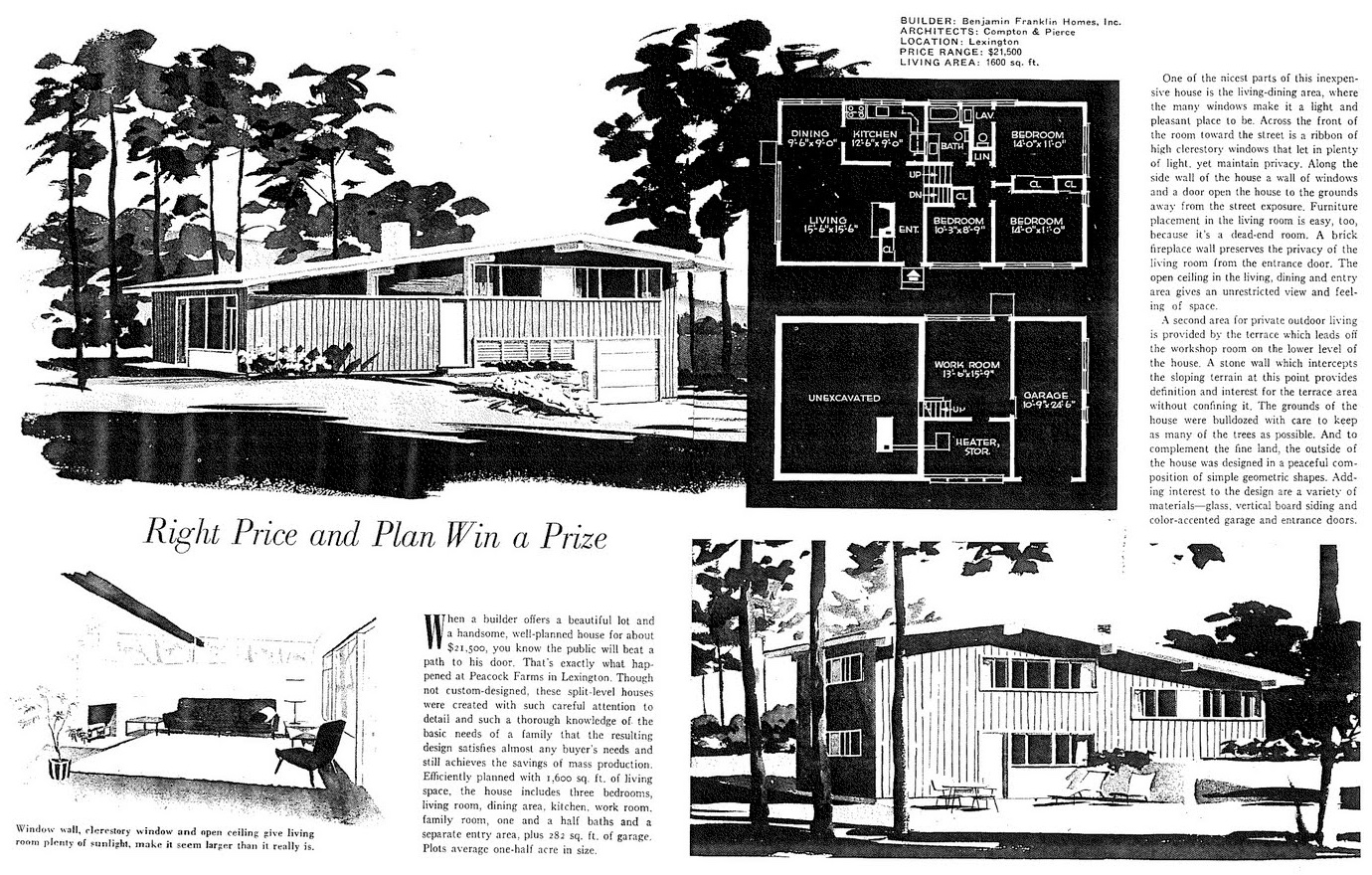 The Peacock Farm home featured in American Home Magazine as a Citation Home (Source: Lexington Historical Commission)
The Peacock Farm home featured in American Home Magazine as a Citation Home (Source: Lexington Historical Commission)
The two Deck Houses feature a simple gable roof shape with broadly overhanging eaves synonymous with the mid-century modern era and aesthetic. Deck Houses often featured symmetrical and expansive casement windows on the gable end, and sliding glass doors on the main level that walked out to a raised deck, and sliding glass doors on the lower level often opening to a terrace. The exteriors were often finished in painted vertical tongue-and-groove cedar siding and mahogany windows. On the interior, post-and-beam construction was utilized where large beams and rafters were exposed and finished with a dark stain. To complement the beams and rafters, tongue-and-groove cedar decking was used as the floor structure and left exposed to create the ceiling surface, which was stained with clear finish to create a natural modern aesthetic.
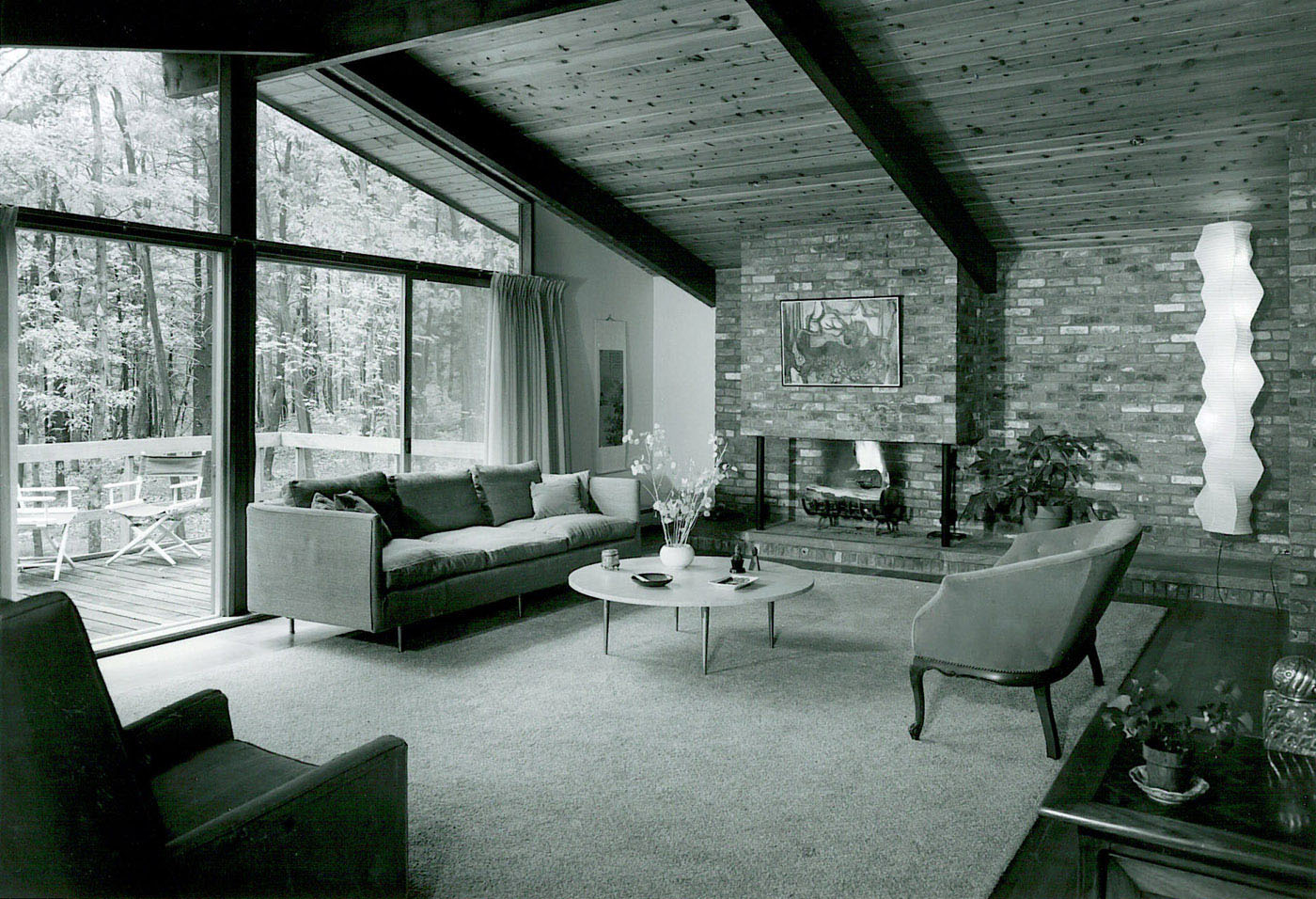 Interior of a Deck House illustrating the gable-end windows and tongue-and-groove cedar decked ceiling (Source: Acorn Deck House)
Interior of a Deck House illustrating the gable-end windows and tongue-and-groove cedar decked ceiling (Source: Acorn Deck House)
Modernism in Massachusetts
Modernist architecture is a type of design that focuses on the form, line, and proportion of structures; an embrace of new and innovative construction methods and materials; and a rejection of unnecessary ordination, symmetric facades, and traditional fenestration. In the 1920s and 1930s, modernist architecture was establishing itself in Germany, France, Italy, and other areas through architecture educational institutions and nascent design firms. In the 1930s and 1940s modernist architecture education was being embraced in the United States, and new architecture, planning, and design schools were being developed and staffed with European-educated scholars, some of whom were fleeing Nazi Germany. In Massachusetts, Harvard University hired figures from Germany's Bauhaus school, including Walter Gropius, Marcel Breuer, and others, in order to develop the Harvard School of Design. Similarly, the Massachusetts Institute of Technology would later transform the Department of Architecture with the addition of modernist architects such as Ralph Rapson, Carl Koch, and others. The end of World War II ushered a surge in enrollment into these and other like institutions, and ingrained modernist principles into a new generation of American architects.
Modernist Development in Lexington
Many of these architects combined their teaching and practice through the local development of modernist houses, both as individual projects and entire developments, in Boston's northwest suburbs of Concord, Belmont, Lexington, Lincoln, and Weston. One of the first modernist homes developed in Lexington was by Harvard's Hugh Stubbins in 1947, and was followed by two modernist housing developments by other Harvard architects operating as the firm The Architects Collaborative (TAC), including Six Moon Hill, developed from 1947 to 1950, and Five Fields, developed from 1951 to 1965. At the same time Five Fields was underway, two MIT-educated architects, W. Danforth Compton and Walter S. Pierce, undertook Peacock Farm on a tract of 42 acres in east Lexington purchased from the George Mason family. The Town approved the subdivision in 1953 and seven custom modernist homes designed by Compton and Pierce were constructed, until Compton's sudden death from polio in 1955. With Pierce left to develop the rest of Peacock Farm himself, he brought in builders Harmon White and Edward Green of Benjamin Franklin Homes in Newton to finish the development. Instead of continuing to design more custom houses, White and Green worked with Pierce to develop a standard design that would appeal to young professionals in the area. Pierce devised a single improved version of one of the "A Series" homes in the development, which became the "Peacock Farm" split-level house. With a standard design that could be easily integrated into the development's varied topology, White and Green built 48 houses of the new design from 1956 to 1958. The development was a success, and the "Peacock Farm" house received national acclaim in 1956 and 1957, including first prize in the national "Homes for Better Living" contest sponsored by the American Institute of Architects, and a First Award from House and Home magazine. The design would later be exhibited in the National Association of Home Builders' Hall of Fame in Washington. With this success, White and Green went on to develop five other neighborhoods of Peacock Farm houses in Lexington, including Upper Turning Mill from 1957 to 1961; Rumford Road in 1959; the Glen at Countryside from 1960 to 1962; The Grove from 1962 to 1964, and Pleasant Brook from 1967 to 1970.
Development of Pleasant Brook
The Pleasant Brook development subdivision was approved by the Town in 1966 on roughly 14.6 acres of land that was formerly the Shanahan Farm, and is directly adjacent to and partially overlaps with the Peacock Farm neighborhood. Like Peacock Farm, Pleasant Brook is the only other of the White and Green neighborhoods that instituted a neighborhood association to protect the houses and neighborhood, via a real estate trust tied to the deeds of the properties. The Pleasant Brook Association trust was first established in 1967 and later amended in 1970 and 1972, and has not been amended since. Through a series of bylaws, the trust codifies architectural, landscaping, and use restrictions intended to preserve the cohesive nature of the development, and is still in place over fifty years later. Interestingly, the properties of 6, 7, 8, 9 Mason and 2, 4, 6 White Pine are dually-deeded into both the Peacock Farm Association and the Pleasant Brook Association, requiring approval from both associations for changes to their structures and landscape. Although these seven lots were part of the original Peacock Farm land purchase and are still part of the Peacock Farm Association, they were not incorporated into the Peacock Farm Historic District. In the National Register of Historic Places application these properties were deemed to be part a distinct second phase of development, and more of the period of the Pleasant Brook development. Unlike the Six Moon Hill, Five Fields, and Peacock Farm developments, no large amount of common land was preserved for use by the neighborhood except for a single lot to the rear of 23 Mason, which contains the Pleasant Brook neighborhood pool.
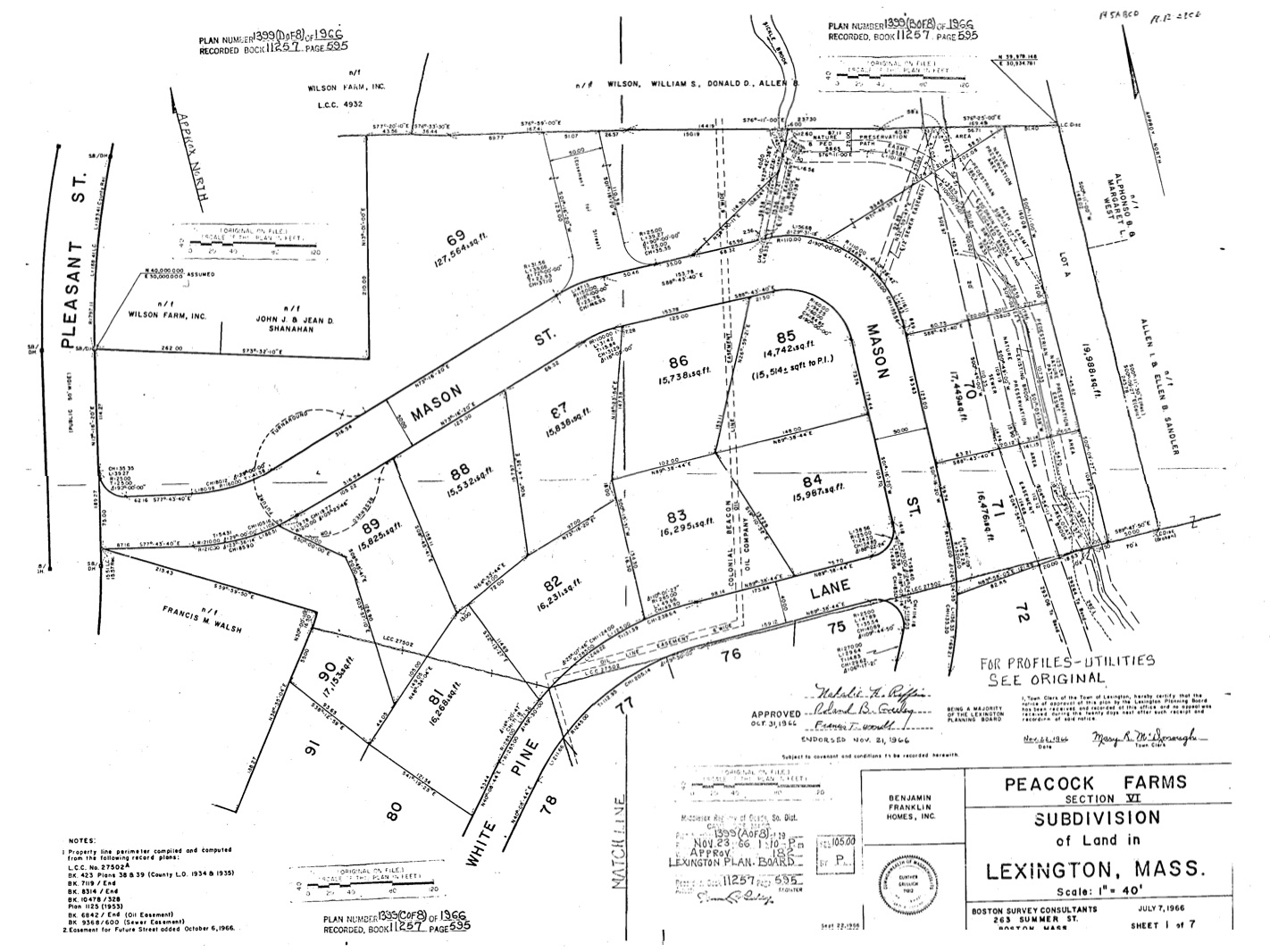 Pleasant Brook original subdivision of land (Source: Lexington Historical Commission)
Pleasant Brook original subdivision of land (Source: Lexington Historical Commission)
Introduction of Prefabrication
Another important theme of the modernist movement in the late 1940s was the concept of prefabrication, which held the promise of economies of scale through the use of indoor production lines to preassemble panels, trusses, and other components which could be joined together on site, rather than built on site from raw materials. Several American modernists demonstrated prototypes of prefabricated modern homes and started small companies to produce them, most of which did not achieve commercial success without broadening to more traditional forms of housing. In Massachusetts, architect Carl Koch worked on a number of prefabrication efforts, before achieving success with his Techbuilt house; a prefabricated and simplified version of his Conantum house, a development of one hundred modern homes built on-site in Concord, Massachusetts. The Techbuilt house was a post-and-beam design comprised of 4'x10' stressed-skin prefabricated panels raised over a poured basement foundation, and saw great success with approximately 3,000 homes built across the country from the 1950s to 1970s, including an entire development in Lexington's Middle Ridge. Several associates at Techbuilt spun off their own prefabrication efforts, including John R. Bemis; who manufactured stressed-skin panels for Techbuilt and pursued his own designs with Koch under Acorn Structures Inc; and William Berkes, who established Deck Houses Inc. with fellow Techbuilt associate Robert Brownell. Over the following decades, Acorn and Deck had a friendly local rivalry with each producing prefabricated homes that had their own signature style; Acorn having a more a traditional New England style and conventional framing, and Deck with their exposed post-and-beam modern structures and signature tongue-and-groove ceiling decking. In 1995, the two companies merged under the name Deck House, Inc. and continued to manufacture both brands, but fell into receivership in 2008 after a failed name change in 2005. In 2009, the company was brought out of receivership and continues to manufacture prefabricated homes today under the Acorn Deck House Company name. It is estimated that Acorn Deck House collectively built more than 20,000 homes nationally and internationally, with a large number of homes in Massachusetts and North Carolina. The house at 12 White Pine has the classic Deck House design, likely a Deck House Model 715, and the house at 14 White Pine is also a standard Deck House model, however, the garages on both houses were added many years later.
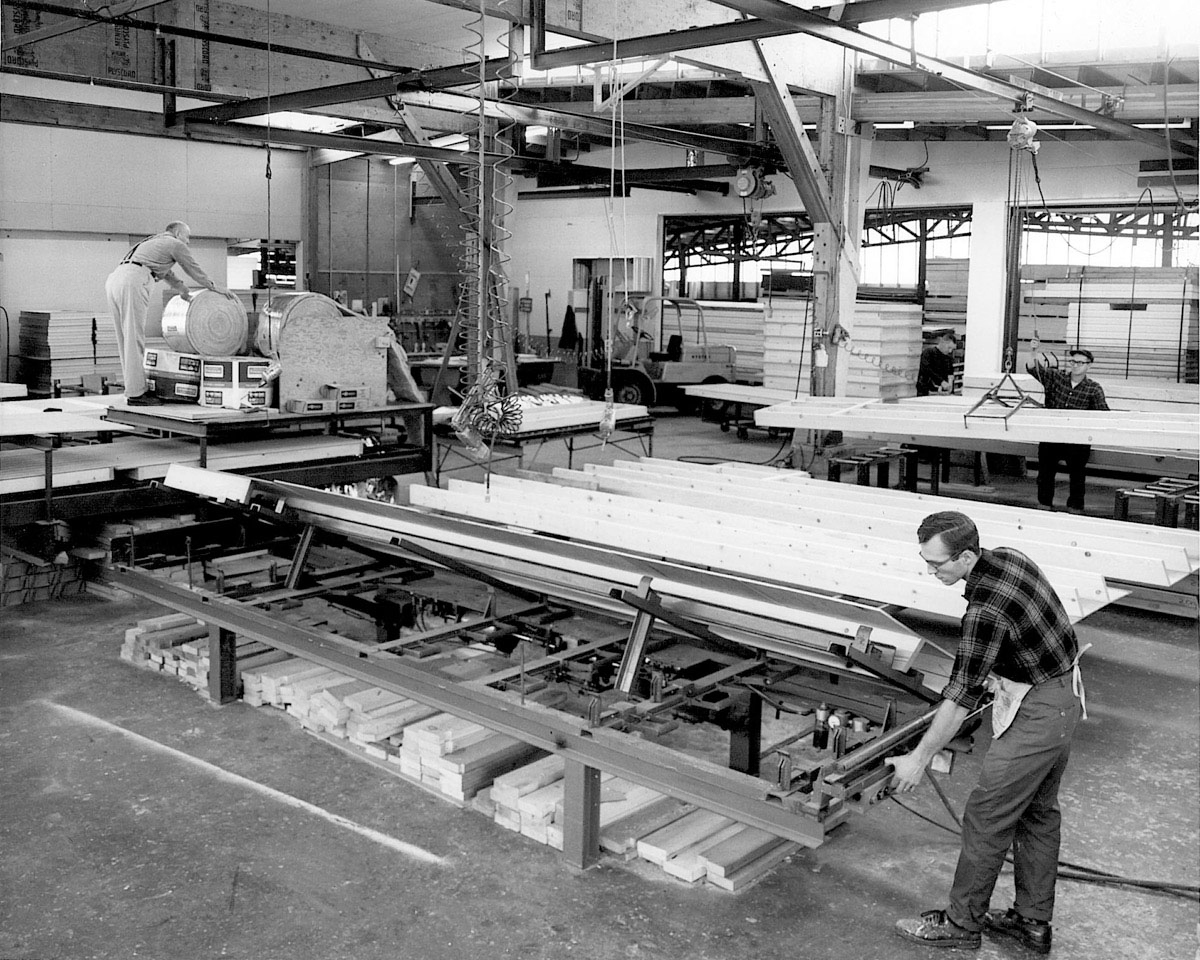 Historical image of the Deck House factory (Source: Acorn Deck House)
Historical image of the Deck House factory (Source: Acorn Deck House)
Modifications and Integrity
Like the other developments of Peacock Farm houses in Lexington, a number of houses have been enlarged over the years. However, Pleasant Brook has a high degree of integrity and has seen fewer major modifications and large additions than most of the other Peacock Farm developments, with roughly 45% of the Peacock Farm houses in Pleasant Brook still in their original living area footprints today. Houses that have had major modifications and expansions include: 1 White Pine, with an added garage and living area expansion; 3 White Pine, with an added garage, screened porch, and living area expansion; 4 White Pine, with an added garage, living area expansion, and change in roofline; 10 White Pine, with an added carport, living area expansion, and change in roofline; 14 White Pine, with an added garage and living area expansion; 18 Mason, with an added garage and living area expansion; 23 Mason, with an added garage and living area expansion; 25 Mason, with an added garage and roof deck; 26 Mason, with an added garage, added roof deck, living area expansion, and change in roofline; 29 Mason, with an added garage, expanded deck, and living area expansion; and 64 Pleasant, with an added detached garage, living area expansion, and change in roofline. Houses that have had moderate modification and expansions include: 5 White Pine, with an attached greenhouse (since removed) and living area expansion; 6 White Pine, with an added sunroom and living area expansion; 11 White Pine, with an expanded deck and living area expansion; 12 White Pine with an added garage; 13 White Pine, with an added carport and living area expansion; 6 Mason, with an added carport and living area expansion; 9 Mason, with a living area expansion; 20 Mason, with an attached covered porch; 21 Mason with a carport; and 27 Mason, with a living area addition. Several houses have replaced the majority of the original single pane steel casement Hope windows, including 3 & 4 White Pine and 6, 7, 8, 15, 17, 21 and 26 Mason. Several houses have alterations to the original 3.5" vertical cedar siding, including 3 & 4 White Pine and 25 Mason. 29 Mason employs a standing-seam metal roof instead of the typical tar and gravel or rubber membrane roof. Several houses feature customizations in their original construction that are uncommon to the typical Peacock Farm house design, including two original stacked-brick fireplaces at 9 White Pine (one since removed), a two-sided wrap around deck on an original poured concrete foundation at 11 White Pine, a lower level constructed for a professional office environment on 11 Mason, and the only known five-level Peacock Farm house at 29 Mason with the original basement under the bedroom side of the house instead of the middle level. Several of the houses appear virtually unchanged and are the most intact in their original form, including 7 White Pine and 19, 22, 24, and 28 Mason.
Bibliography and References
- Clouette, Bruce, and Friedberg, Betsy, "National Register of Historic Places Multiple Property Documentation Form: Mid-Century Modern Houses of Lexington Massachusetts", Massachusetts Historical Commission, 2012
- Clouette, Bruce, and Friedberg, Betsy, "National Register of Historic Places Registration Form: Peacock Farm Historic District", Massachusetts Historical Commission, 2012
- Grady, Anne, "Area S: Peacock Farm", Massachusetts Historical Commission, 1984
- Mauslof, Lisa, "Area I: Middle Ridge", Massachusetts Historical Commission, 2000
- Mauslof, Lisa, "Area AK: Glen Estates, The Glen at Countryside", Massachusetts Historical Commission, 2000
- Mauslof, Lisa, "Area AL: The Grove", Massachusetts Historical Commission, 2000
- Mauslof, Lisa, "Area AM: Rumford Road", Massachusetts Historical Commission, 2000
- Mauslof, Lisa, "Area AN: Upper Turning Mill", Massachusetts Historical Commission, 2000
- Seasholes, Nancy S., "Area R: Moon Hill", Massachusetts Historical Commission, 1984
- Seasholes, Nancy S., "Area U: Five Fields", Massachusetts Historical Commission, 1984
- Middlesex South Registry of Deeds. Various deeds and plans. Cambridge, Massachusetts.
- Town of Lexington, Assessor's Office. Property assessment database. Lexington, Massachusetts.
- The Town of Lexington, Planning Department. Maps & Geographic Information Systems. Lexington, Massachusetts.
- "Pleasant Brook Association Declaration of Trust", Pleasant Brook Association, 1972.
- "Pleasant Brook Association Bylaws", Pleasant Brook Association, 1971.
- "Pleasant Brook Association Deed Restrictions", Pleasant Brook Association, circa 1970.
- "Pleasant Brook Association Architectural Restrictions", Pleasant Brook Association, 1970.
- Janovitz, Bill, and Tse, John, "Interview with Walter Pierce (2011)", modernmass.com, accessed April 2020
- TechBuilt Research website, thetechbuilthouse.com, accessed May 2020
- Acorn Deck House Company website, deckhouse.com, accessed May 2020
- NC Modernist website, ncmodernist.org, accessed May 2020